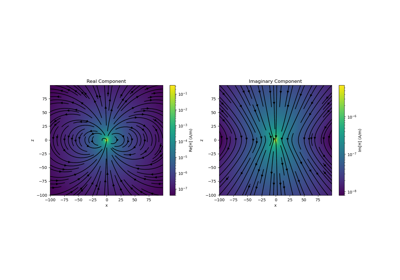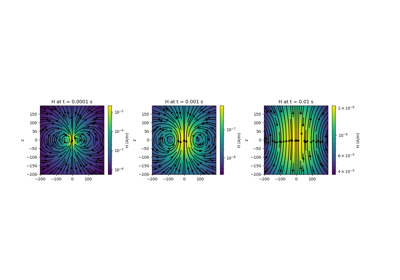SimPEG.utils.ndgrid#
- SimPEG.utils.ndgrid(*args, vector=True, order='F')[source]#
Generate gridded locations for 1D, 2D, or 3D tensors.
For 1D, 2D, or 3D tensors, this function takes the unique positions defining a tensor along each of its axis and returns the gridded locations. For 2D and 3D meshes, the user may treat the unique x, y (and z) positions a successive positional arguments or as a single argument using a list [x, y, (z)].
For outputs, let dim be the number of dimension (1, 2 or 3) and let n be the total number of gridded locations. The gridded x, y (and z) locations can be return as a single numpy array of shape [n, ndim]. The user can also return the gridded x, y (and z) locations as a list of length ndim. The list contains entries contain the x, y (and z) locations as tensors. See examples.
- Parameters
- *args(
n,dim)numpy.ndarrayor(dim)listof(n)numpy.ndarray Positions along each axis of the tensor. The user can define these as successive positional arguments x, y, (and z) or as a single argument using a list [x, y, (z)].
- vectorbool,
optional If True, the output is a numpy array of dimension [n, ndim]. If False, the gridded x, y (and z) locations are returned as separate ndarrays in a list. Default is True.
- order{‘F’, ‘C’, ‘A’}
Define ordering using one of the following options: ‘C’ is C-like ordering, ‘F’ is Fortran-like ordering, ‘A’ is Fortran ordering if memory is contigious and C-like otherwise. Default = ‘F’. See
numpy.reshape()for more on this argument.
- *args(
- Returns
numpy.ndarrayorlistofnumpy.ndarrayIf vector = True the gridded x, y, (and z) locations are returned as a numpy array of shape [n, ndim]. If vector = False, the gridded x, y, (and z) are returned as a list of vectors.
Examples
>>> from discretize.utils import ndgrid >>> import numpy as np
>>> x = np.array([1, 2, 3]) >>> y = np.array([2, 4])
>>> ndgrid([x, y]) array([[1, 2], [2, 2], [3, 2], [1, 4], [2, 4], [3, 4]])
>>> ndgrid(x, y, order='C') array([[1, 2], [1, 4], [2, 2], [2, 4], [3, 2], [3, 4]])
>>> ndgrid(x, y, vector=False) [array([[1, 1], [2, 2], [3, 3]]), array([[2, 4], [2, 4], [2, 4]])]




